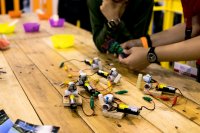Preserving the Early Excitement of STEAM
An educator argues for keeping the creative spark of primary school STEAM education as students move into middle school.
STEAM education (science, technology, engineering, the arts, and math) encourages investigation, hands-on learning, and creativity and incorporates interdisciplinary learning.
I often say that STEAM education happens the most in early childhood, and has been for decades: Young students often gather for circle time and begin their day with songs that focus on academic content. Walls are covered with art that students have produced to learn about shapes, colors, or sight words.
Then students are sent off to centers to explore, through hands-on work and self-exploration— they build models and learn by trial and error. The teacher serves sometimes as the facilitator and other times as the instructor, helping students make connections and understand the standards associated with their tasks.
Changes in STEAM Education in Middle School
Fast-forward to middle school. While there are some schools that have circle time and morning meetings and incorporate interdisciplinary learning through the use of STEAM education, that’s more of an exception than a norm.
I’ve taught in early childhood education and in elementary and middle schools, and I’ve witnessed the change. Why do we change our methods drastically, while asking for deeper understanding?
STEAM education is bigger than the subjects the letters represent—it’s the practices, creative spark, and growth that can be gained from engaging in all of them simultaneously.
Several years ago my middle school teaching team decided to engage our students in the study of multiplication through music. The overall goal was to familiarize students with facts needed for immediate recall in higher-level mathematics. This was targeted instruction for students to bridge learning gaps—traditional models had not been successful for them. We told them to be creative, have fun, and most importantly show they understood the concepts. The kids were so engaged and excited to let their creative expression flow.
They practiced daily, and came up with introductions and choreography. They were out of their seats, on the floor or moving around, and they were engaged in math. It was wonderful! Our students who struggled to stay focused or were generally uninterested in multiplication, or math in general, were leading during this time—the incorporation of arts and interdisciplinary learning had set a spark in them.
Junior Film Directors
Imagine welcoming your class one day and telling them they won’t be students that day—they’ll be filmmakers. Tell them they’re going to make short movies that display their understanding of ratio and proportion, as well as a few other math standards, and let them know the videos will become a part of an online math resource center for students. This project can be done over a few class periods, or if time permits you can commit an entire class to completing the films.
Sixth-grade math standards include students’ ability to understand ratio and proportional relationship, as well as statistical questions. These concepts could be explored with a scene that involves preparing for a party—that would lead students to determine total costs when given the unit prices for snacks, and to figure out how much they’ll have to pay the party entertainment, cleaning crew, etc., when given the hourly wage. Or students could explore ratios of ingredients in cake or pizza dough recipes—how would the numbers change with different numbers of guests?
Have students develop at least one statistical question to be used in their scene, and remind them that statistical questions are ones that can be answered through data collection. Helping students make a connection to how they can use ratio, data collection, and statistical questions to problem solve in their everyday lives makes for an engaging and meaningful learning experience.
As the teacher you are the director, providing guidance, facilitating, and instructing. Allow students to guide their own learning and utilize online resources. You’ll probably need to remind them that their movie must exemplify the learning standard, and you’ll need to guide them to make connections to their STEAM education throughout the process. Encourage them to self-reflect during the revision process and to focus on the mechanics of making a movie.
Have your students evaluate themselves using a rubric you create—include a scale for how well they engaged, exhibited mastery of the standard, and understood the process. For additional assessment, or to assess a different standard, students can do a teach back to show their level of understanding or create a written reflection or exam.
This project is interdisciplinary, promotes collaboration and creativity, and incorporates not only STEAM standards but English language arts ones as well. Finish strong by doing film previews, by grade level or the whole school—you can roll out the red carpet, invite families, and have students be prepared to make an introductory speech before their movies.
Engaging our students in STEAM education and its principles allows for a very enriching experience—students identify how they can apply course content and concepts in the real world.
When someone walks into a classroom in the 21st century, it should be unclear exactly what subject the students are engaged in—the lines between subjects should be blurry, or removed, and the only thing that should be clear is that students are engaged and learning.
